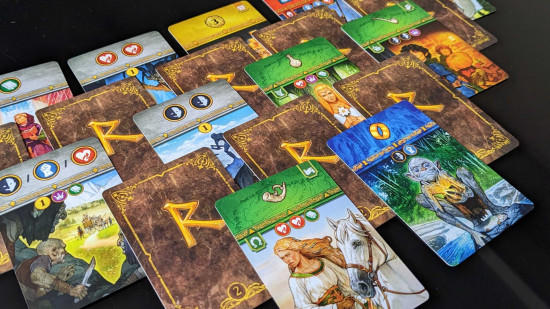7 Wonders Duel, one of the most popular two-player board games, has been adapted into a new Tolkien-themed tabletop title. It’s clear that plenty of DNA has been passed down, but The Lord of the Rings: Duel for Middle-earth does attempt to add its own spin to the original’s tried-and-tested rules. Unfortunately, even the smallest game mechanic can change the course of the future – and these new features both help and hinder the overall experience.
First, let’s talk about what feels homey and familiar, in case you haven’t tried the original two-player board game. Like the 7 Wonders version, Duel for Middle-earth is a head-to-head that plays out across three ages. Only this time, one player represents the Fellowship and the other the forces of Sauron.
On their turn, players can select and ‘build’ a card or location tile from a public pool, provided they can pay the associated costs. This might mean handing over some gold or having a certain card/s already constructed in your private play area.
Your goal here is to trigger one of the game’s three victory conditions. The first involves advancing far enough on the game’s ‘Quest of the Ring’ track. Like in the original game, a player can net themselves an immediate victory by tipping the scales far enough in their favor.
The second way to win also imitates 7 Wonder Duel. Instead of science tokens, Duel for Middle-earth has ‘race’ tokens that can be collected by constructing green cards with matching race symbols. These tokens offer unique benefits, and you can win the game instantly by constructing six green cards with different race symbols. It’s slightly tweaked from the science win condition in the original, but the core principle is very similar.
The final victory condition is where Duel for Middle-earth attempts to stand out. While 7 Wonders Duel has victory points that can secure you a win, its Lord of the Rings board game counterpart comes with a map you must conquer. Certain cards and tiles allow you to place and move units in key locations across Middle-earth.
If your army is present in all seven regions, you instantly win the game. And if you can’t manage that, the player present in the most regions after the three ages are over is declared the winner. Should you both have an equal number of cities conquered, the result is a tie (not sure how that would have played out in the original trilogy).
The miniature war taking place beyond the card drafting is easily the most exciting part of the game. You’ll watch your dominance of Middle-earth ebb and flow, and it gives you an opportunity to interfere with your enemy in an otherwise quite solitaire-like game. In my initial playthroughs, it also seemed like the most viable win condition, so it was where most of our attention was focused.
When the One Ring wanted to be found, darkness again began to creep into the forests of Middle-earth. I had a similar creeping feeling come over me in the midst of battle. While lots was right about this combat system, some things were wrong, too.
This micro-wargame highlights just how poor a fit the Lord of the Rings theme is for 7 Wonders’ rules. The original game is about building wondrous monuments, so it makes sense that the entire rules system is about ‘constructing’ buildings with ‘resources’, as well as trying to outdo the military and scientific might of rival cities.
Duel for Middle-earth has no thematic way to explain why you’re collecting cards and landmarks. The military aspects translate to a degree, but the most identifiable aspects of the original game simply don’t land the same.
Duel for Middle-earth wants to be a low-complexity wargame, but it’s stuck with cumbersome card-drafting mechanics to shoehorn in. And in doing so, it weakens the combat mechanics it’s tried so desperately to include.
The rules for maneuvering units are disappointingly simple. When units from opposing armies are in the same location, each player simply removes a unit until at least one player has none left in that region.
Fortresses can be built to assert control in a location, but they don’t engage with enemy units that enter the area. Very little attention is paid to tie-breaker situations, which can leave you with a stalemate where both players control as much land as their rival, without many ways to turn the tide of war.
I tested this game with my fiancé, who isn’t much of a board gamer. He enjoys low- to mid-complexity titles from the roster of best board games, but even he was lamenting how simplified the combat rules were. He spent half the game wishing there was more meat on the bones.
If I want to put meat back on the menu, I probably won’t play Duel for Middle-earth again. Instead, I think now would be the perfect time to introduce my partner to War of the Ring – a game where we can stage a proper battle for Middle-earth.
For the purposes of testing, my copy of Lord of the Rings: Duel for Middle-earth was provided by the publisher. For more gaming suggestions, here are the best board games for couples, as well as the best war board games.
Source: Wargamer




